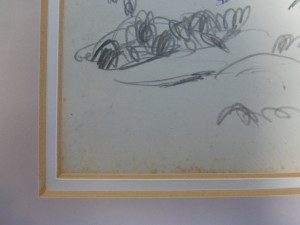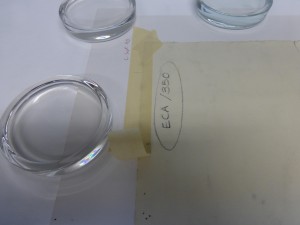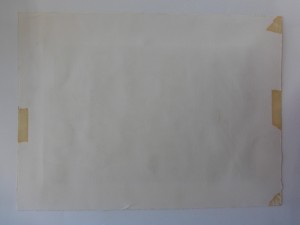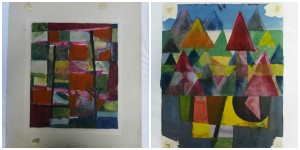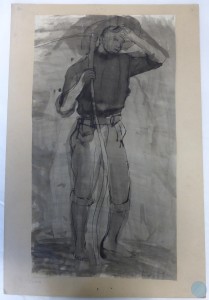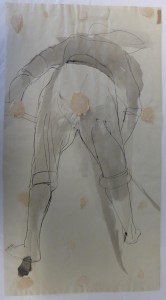At the start of April, I started conservation work on the Edinburgh University Art Collections. I had previously been working at the Lothian Health Services Archive on a 12-month project to conserve their HIV/AIDS collections. When this came to an end, I was delighted to be offered the chance to work on a new collection at the University.
I started off by unframing a selection of works of art on paper. These items has been previously framed using low quality mountboard. This can be damaging to the artwork as this board can become acidic over time, which can migrate to the artwork and cause staining.
Unframing artworks is great fun as you never know what you will find underneath. Sometimes, you can find interesting inscriptions or hidden sketches, however, often you find more conservation problems! In this collection, I found that many artworks had been adhered into frames using pressure sensitive tapes, such as masking tape and sticky tape. Tapes such as this can become stuck on to the paper and be very difficult to remove. To remove these tapes, I used the gentle application of heat which softens the adhesive and makes it easier to peel off using tweezers and a spatula.
As these tapes age, it becomes even harder to get them off and the adhesive can soak into the paper causing staining. To remove these aged tapes, solvents can be applied using a poultice. However this can be time consuming, and has health and safety issues due to the exposure to solvents.
Another problem I encountered was that some artworks were adhered overall to a piece of mountboard. This can be problematic if the mountboard is acidic as this acid can migrate to the paper and cause weakening and discolouration of the sheet. Also, if the artwork is stored in high or low humidity, the mountboard and paper will react differently to moisture, and potentially cause cockling (paper conservation term for rippling of the sheet) and tearing. Boards such as this can be removed in small pieces by using a scalpel with a number 22 blade. The layers closest to the artwork can then be removed using a poultice such as the one described in Samantha Cawson’s blog.
When an artwork is unframed, it can give you clues to it’s original condition. For example, when I unframed this artwork by Anne Redpath, I found that there was a clear difference between the areas that could be seen and the areas underneath the window mount. The paint that was white in the exposed area, is pink in the hidden areas; the blue in the visible area is red underneath the mount! The difference in colours could be caused by the effect of light on the exposed areas of the artwork, which has caused the pigment to fade. Equally, the pigments may have changed colour due to contact with an acidic window mount. More research is needed to find out the exact cause. As you can see this discolouration has completely changed the look of this painting and it is hard to imagine how it could of looked originally.
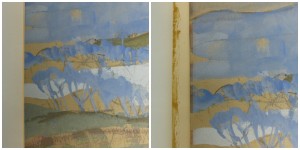
Painting by Anne Redpath, before (left) and after (right) unframing. Note the difference in colour between the areas hidden and exposed to light
Sometimes during unframing you can also discover things that are completely new. For example, after I had unframed this watercolour by Alan Davie, I found another watercolour painted on the other side! This watercolour has been protected from the light, and so the colours have remained very bright and vibrant.
Here is another sketch I found underneath a mount. The card mount had been adhered to the back of the artwork with multiple dots of glue. I removed the card mount using a scalpel which revealed another sketch of a similar model on the recto, and then removed the adhesive residue using a CMC poultice. This reuse of the sheet is common among artists as a way of making the most of expensive art materials!
Good framing is essential to the longevity of an artwork. When framing works of art on paper, always use good quality inert materials, such as 100% cotton rag mountboard, and use reversible adhesives such as wheat starch paste. Never adhere artworks directly to a secondary support, instead use hinges made from Japanese paper. And please do us paper conservators a favour, never use pressure sensitive tapes on paper artworks!
If you would like any advice on framing artworks, please do get in contact or check out this website: http://www.conservationregister.com/PIcon-Mounting.asp
Emily Hick
Paper Conservator
Emily.hick@ed.ac.uk

